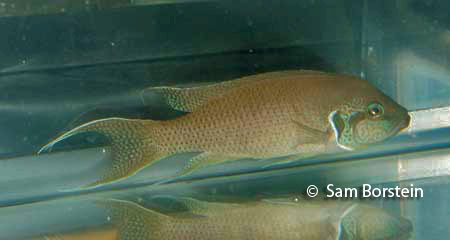Neolamprologus brichardi
(Poll, 1974)
Brichardi
Synonyms: Lamprologus brichardi

Above: A male Neolamprologus brichardi . Photo by Sam Borstein.
Etymology:
Genus- Neos= new (Latin), lampas= Bright (Latin), lagos= hare (Greek).
Species- brichardi= named after Pierre Brichard.
Intro:
Neolamprologus brichardi is a relatively small substrate spawner from Lake Tanganyika. Even though this fish does not have much color, it is very interesting in its behavior, and is one of the most popular Tangs behind Frontosa and Tropheus.
The Neolamprologus bichardi complex consists of:
- Neolamprologus brichardi
- Neolamprologus crassus
- Neolamprologus cygnus
- Neolamprologus falcicula
- Neolamprologus gracilis
- Neolamprologus helianthus
- Neolamprologus marunguensis
- Neolamprologus olivaceous
- Neolamprologus savoryi
- Neolamprologus splendens
- Neolamprologus walteri
Distribution:
Neolamprologus brichardi are found in the rocky areas throughout Lake Tanganyika. It is a highly variable species depending on location.
Size, Maturity, and Sexual Dimorphism:
Size: Males- 4 inches, Females- 3.5 inches
Maturity: 1.75 inches
Sexual Dimorphism: Males are larger and have longer fins.
Care:
Neolamprologus brichardi is small, but pretty aggressive. They will do fine in a community tank, as long as they are put with fish with similar requirements that are bigger, and can hold their owNeolamprologus Neolamprologus brichardi will do fine in a species tank as well. It is also possible to keep a bonded pair in a tank as small as 10 gallons by themselves although a larger tank like a 20 gallon or a 40 breeder is recommended.Diet:
Neolamprologus brichardi is a carnivore. Make sure they get food with protein. They especially love brine shrimp.Breeding:
The whole Neolamprologus brichardi complex has a lot of neat breeding behaviors. A nice thing about these fish is that they will raise numerous broods in a tank, the juvenile fish from the last spawn will even help defend the territory. In a small tank, the fish will usually kill down to a pair and then breeding will begin. In a larger tank, the pair will stake out a territory and defend it.
The pair will usually spawn in a cave that has a relatively small opening. Mine bred in barnacles. The fry are small and defended by the parents fiercely. The fry are easily raised on baby brine shrimp and for Tangs grow relatively fast. You should always feed your shell dwellers and other Lamprologus baby brine shrimp, because you never know when they are on a spawn because they don't let the fry out until they are close to half an inch.
Conclusion:
This popular Tanganyikan is a great fish and easily attainable. It is a great fish for a beginning cichlid keeper to try.
References:
- Konings, A. (1998) Tanganyikan cichlids in their natural habitat. Cichlid Press, El Paso, Texas, 272 pp.
